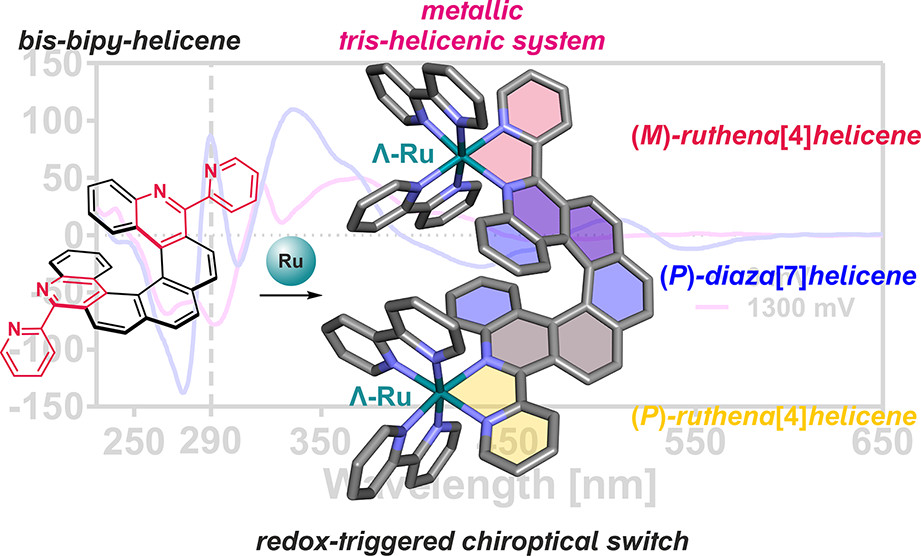Helical molecules are synthetic targets of the Department of Organic Synthesis and Advanced Materials of our institute for a long time. The research team led by Dr. Církva has recently developed a new photochemical method for the preparation of helicenes containing nitrogen atoms in their scaffold, so-called aza[n]helicenes. Such molecules have potential application in molecular electronics. The newly prepared azahelicenes contained also bipyridyl motives that can be used as ligands for complexing transition metals which can lead to further modification of properties of the original molecule. In cooperation with prof. Jeanne Crassous of the University of Rennes, the prepared ligands were used for the synthesis of ruthenium complexes. This work was carried out in France within the project OP VVV Mobility II and the results achieved became a basis for a publication that was recently published in the prestigious Inorganic Chemistry journal.
In this work, the synthesis of new aza[n]helicenes containing 4 – 7 aromatic benzene units was described in detail together with their photophysical and chiroptical properties. The new compounds were prepared by a modified Mallory reaction using aromatic imines as precursors. The new, helical 2,2′-bipyridine ligands formed were in France coordinated to Ru(bipy)22+ units to form the [RuL (bipy)2]2+ or [Ru2L′(bipy)4]4+ complexes where L and L ′ stands for new aza[n]helicenes. Coordination to Ru(bipy)22+ unit also resulted in the formation of diastereomerically and enantiomerically pure forms of complexes, which were studied from the topological and stereochemical point of view by X-ray crystallography. It is noteworthy that coordinating the helicene ligand to Ru2+allows for the formation of other helical structures at the helicene periphery containing the coordinated metal in its scaffold. These molecular fragments were entitled ruthena-helicenes. Subsequently, photophysical, chiroptical, and redox properties of these complexes were investigated. The finding that in the bis-ruthenium complex there is a significant change in the absorption of circularly polarized light between its oxidized and reduced form of Ru3+/Ru2+ belonged among the most interesting results of this work. The largest change was observed at a wavelength of 290 nm when even the change in the sign takes place. The process is fully reversible as confirmed over 10 cycles without reducing the intensity of the response. Thus, the bis-ruthenium diaza[7]helicene complex exhibits a chiroptical Ru3+/Ru2+ redox-triggered switching activity.

- Kos, M.; Rodríguez, R.; Storch, J.; Sýkora, J.; Caytan, E.; Cordier, M.; Císařová, I.; Vanthuyne, N.; Williams, J.A.G.; Žádný, J.; Církva, V.; Crassous, J.: Enantioenriched Ruthenium-Tris-Bipyridine Complexes Bearing One Helical Bipyridine Ligand: Access to Fused Multihelicenic Systems and Chiroptical Redox Switches. Inorg. Chem. 2021, 60(16), 11838–11851. https://doi.org/10.1021/acs.inorgchem.1c01379